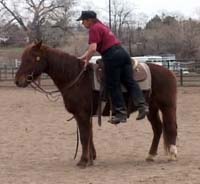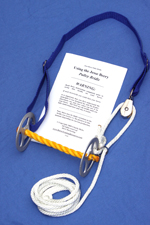My Horse Won’t Stand Still!
First – A nice note I received from Lucy a while back:
“I’ve been getting your daily emails for a while now and i
just wanted to say what help they have been.
i have a 4 (nearly 5) year old welsh who is lovely in
every way but is sometimes a bit spooky out hacking and some
times forgets who’s the owner.
With your emails, i have learnt a lot on how to control him
and teaching him new things. as i was told before, a horse
never stops learning.
He’s come on leaps and bounds and i wanted to thank you once again.
Keep it up – and a note to other horse owners with problem horses:
Keep trying. a dream is the hardest thing to achieve. but
when you have it, it’s Amazing.
thanks again, Lucy and Toby x”
—————
A common question I get is:
 “What do I do when my horse won’t stand still?”
“What do I do when my horse won’t stand still?”
Their horse won’t stand when mounting and, in many cases,
the horse won’t stand still for anything – mounting,
grooming, saddling, picking up his feet, etc.
This is a common problem and may have a few different causes:
1. First – training, or lack of training. I’m not trying
to be cute but many horses simply haven’t been trained to
stand still when mounting. They start to move once you
place weight on the stirrup or start to put the saddle
blanket on, etc. If you continue to let them get away
with it then it forms a bad habit and they will always do it.
In short – they have conditioned YOU to put up with it!
2. The second cause could be due to discomfort. If your
horse has sore muscles, saddle sores, poor-fitting tack,
etc. then the horse may be reacting to the discomfort.
Remember – horses will tend to move away from pressure
or pain. (Wouldn’t you?) If they’re moving when you
mount it might be due to discomfort.
Make sure your tack fits right, that the horse doesn’t have
lumps or sores, and that the girth and cinch are done properly.
If you are unsure or find some tender spots, you might
want to have the vet look at him.
Mounting, especially when using a Western saddle, puts a
lot of pressure on the horse and the twisting and pulling
is throwing the horse out of balance. You can imagine
that it’s somewhat natural for the horse to react to those
pressures if not trained to stand.
So…assuming it’s not a physical problem with the
horse and not a tack problem, let’s examine how we
can keep your horse from moving while mounting:
Remember – teaching a horse anything is a process of
forming good habits and impressing upon them what is right
and wrong through positive feedback or working them.
If you ask a horse to do something and they do it, you
reward them with good words, pats and gentle strokes.
If they do not do what you ask, you have them do work
or apply pressure and then try it again. This is basic
horse training 101.
After they do the work or you let up the pressure, you
ask them (or lead them) to what you want them to do again.
If they do it, you reward them. If they don’t, you work
them again.
Sort of like ‘wash – rinse – repeat’.
Some horses require more work than others. They all have
different dispositions and react to different training
methods (just like my 5 kids!).
If your horse starts to move when mounting then one
way to handle it is to not finish mounting, take the
horse and work it in the round pen a minute or two and
then try to mount again. If the horse continues to move,
work the horse again. Eventually, the horse will get
the message – if I move, I get worked.
(Wash – rinse – repeat).
However, at the point the horse doesn’t move then
reward him right away. You can do this in steps –
put your foot in the stirrup and start to apply weight,
then get off and reward him. Next, put more weight on,
but don’t fully mount, dismount and reward him.
Again – reward positive actions.
This process works for many horses but takes time. And
you have to continue to reward the horse each time
you mount to fix the positive habit.
But what do you do with the horse that won’t stand
for anything due to his disposition or past problems?
Prof. Beery’s Pulley Bridle – it is so effective for
so many problems it is worth having. It is adjustable
for almost any size horse and is simple to use.
Using the pulley bridle, you can quickly cure a horse
from multiple negative habits. The method is very effective
due to applying pressure on top of the neck right behind
the ears. There are exposed nerves there that will
literally stop a horse in his tracks if the pressure is
applied properly (and MUST be used properly).
In many cases only a couple quick jerks on the rope
of the pulley bridle will completely cure the horse.
And, it works great to teach a horse to let you lift its feet,
from shying at various things, teaching it to follow you,
backup, etc. It’s a tremendous training aid.
The Pulley Bridle is a training tool to be used only
when working on specific problems. It is not a “riding
bridle”.
I would suggest most first-time users to have an assistant
with them when using the Pulley Bridle.
The pulley bridle is a great time saver since it
is so effective.
You can read about the pulley bridle here:
http://www.
And the Beery Course here:
http://www.
The bridle comes with full instructions and examples of
use for various bad habits. Be sure to read the instructions
before using the pulley bridle. It is to be used for
training purposes only.
Honestly, with the combination of the “Jesse Beery 8 Volume
Course on Horsemanship” and the Pulley Bridle, you can solve
95% of your common horse problems.
If you will take the time to read and study the horse
training methods in the Beery course and use his
methods as he describes, you WILL be able to solve
your horse problems. As you learn how a horse thinks,
how his brain works, how he learns and about their
dispositions – you’ll have an insight that a large
percentage of horse owners simply don’t understand.
http://www.
And, when you understand how such a simple device
can make such a HUGE difference in your training
without harm, you’ll probably wonder why you
didn’t try it earlier.
Tens of thousands have used the Beery Course
and the pulley bridle for over a century now.
In fact, most successful big-name horse trainers
cut their teeth using the Beery Course.
http://www.
Take time to train your horse… your efforts will be
well-rewarded. Both you and your horse will enjoy each
other so much more. How long will you continue to put
up with a horse that has many bad habits?
Enjoy your horses….please do it safely.
Charlie
P.S. Take 10% OFF ANYTHING in your shopping cart
by using the coupon code CHARLIEHORSE.
——-
“Nothing positive changes with horses
(or life in general) until you take action.”
——-


